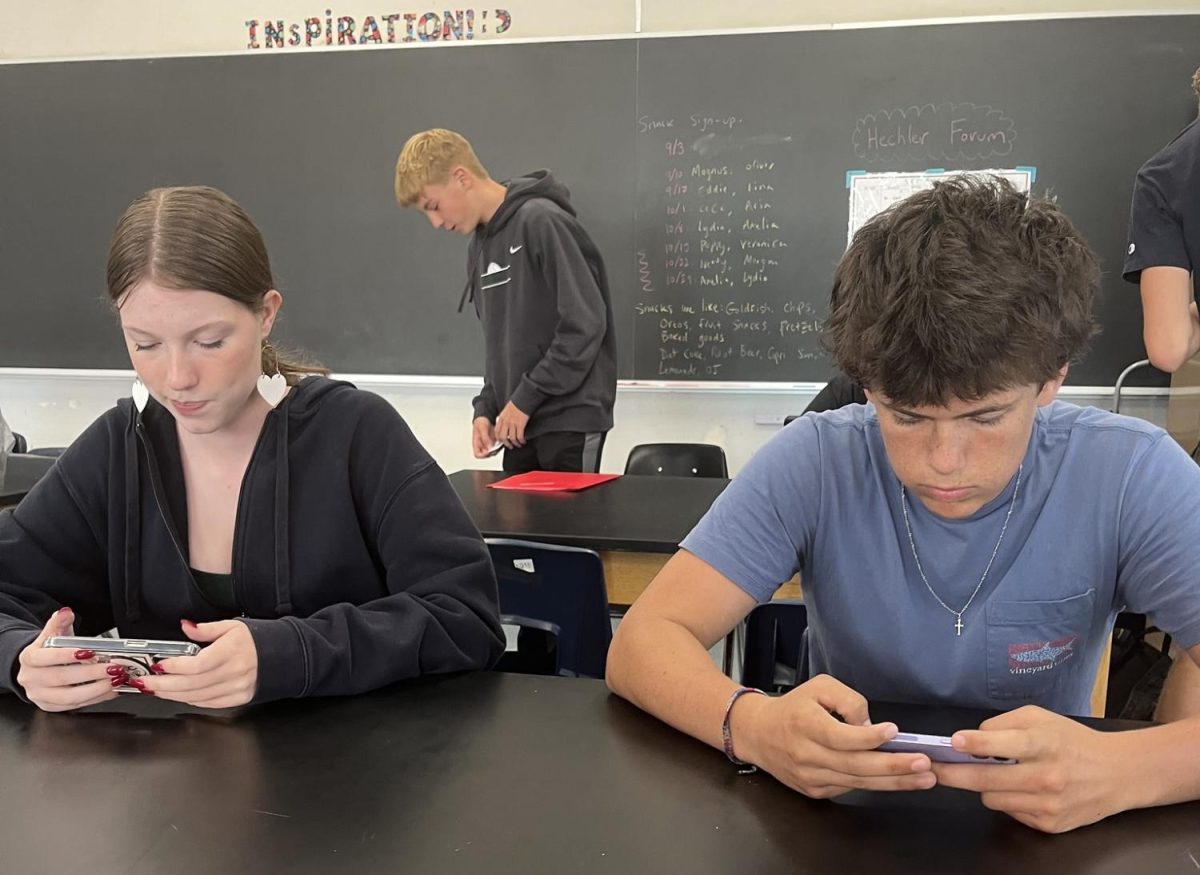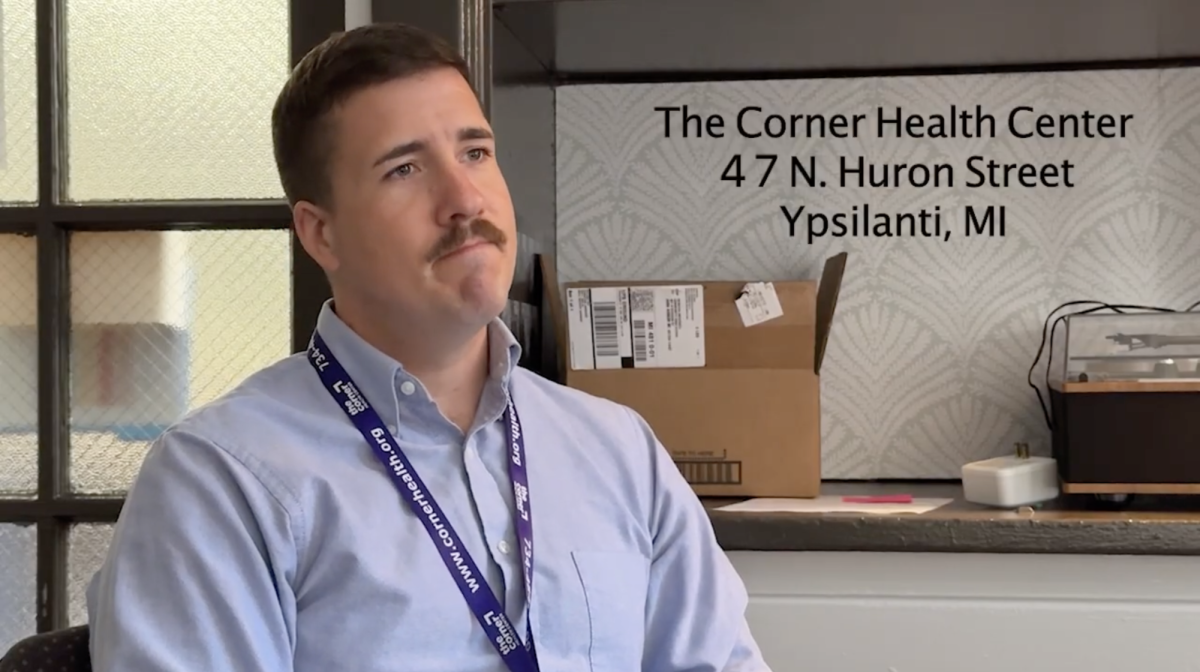As Ryan Silvester walked into his room lit with the sun of a mid-August morning he immediately knew that something was missing.
“‘Stefan’ was back there, and there were no magnets,” Silvester said. “My industrial strength magnets were gone.”
“Stefan,” a name given to Silvester’s phone caddy, after the action of stuffing one’s phone into the pouch, required magnets. With those magnets gone, Silvester had no choice but to find an alternative. Something in this bizarre occurrence gave Silvester the push he needed to decide that this would be the year to finally put “Stefan” to use.
“I’m like, ‘Oh, there’s this cool box, It can be “Stefan Jr,”‘” Silvester said. “Then the more I thought about it, the more I was like, ‘Well, why don’t I try?'”
In years past, “Stefan” had been used as a last resort to keep phones from distracting students in his classroom. The idea was to let students find what works or doesn’t work for them while still maintaining an active learning environment. In theory, this would teach them self-control they would have to learn in their adult lives one day.
For his first six years of teaching, Silvester didn’t have phone policies and this idea of teaching his students self-control and responsibility was one of the primary reasons. He worried that taking away phones wouldn’t set up his students for success in the future, when they didn’t have someone to remove this distraction for them. This year though, Silvester decided to try it, to see how it went. He has seen so much more engagement and while this is still a worry for Silvester, he has noticed many students independently choosing to remove their phones from their learning, more and more. As Silvester gives students the opportunity to see what happens when they remove their phones, they can find the motivation to work on the self-control that Silvester wanted to maintain.
With “Stefan Jr,” Silvester has his students put their phones in the box as soon as they walk in, preventing any distractions in class and keeping their minds off their phones. As a clinical professor at the University of Michigan in the Marsal Family School of Education, Liz Kolb has found in her research that even having phones close to students can impact the way that they learn.
In one study, Kolb found that cell phones can be distracting even if they aren’t in use. She noticed that when students had their phones close to them, they retained information worse than students that completely separated phones from their learning environments.
For, Clara Freeth, a senior at CHS the distractions of cell phones, whether in use or not, have been apparent in her experiences. Specifically, when she was in Silvester’s world history class, in her sophomore year.
“It was quite something,” Freeth said. “I remember sixth-block world history is where I learned that the Queen of England had died, everybody was going crazy and it was because we were all on our phones.”
So after a semester of frustration, Silvester decided to bring out “Stefan.” This decision was not taken well by the class, as the students were used to having their phones and didn’t appreciate the change.
“I felt like [removing phones] failed,” Silvester said. “There was so much fighting.”
After that, Silvester didn’t continue carrying out any specific phone policy and continued to experience the frustrating distraction of phones in his classroom. Silvester felt that he was always asking his students to put their phones away. It got to a point where he felt hopeless, that there was nothing he could do, and that his effort wasn’t worth it. Ultimately though, Silvester is so glad he put that last sliver of patience he had into “Stefan,” because of the payoff he is seeing now.
Silvester has adjusted the way he approached phone policies since that world history class. This year he set his rules around phones early and clearly. This year, the difference in engagement has been striking and relieving for Silvester.
“People are up. People are engaged. People are in groups,” Silvester said.
One class that has adapted well to the new policies is Silvester’s Modern Global Relation’s class. Ryan Grant, a senior at CHS, is in this class. Grant, someone who has struggled with disconnecting from his phone in the past, has found Silvester’s phone policy to be beneficial. Because in years past, Grant has experienced exactly what Kolb sees in so many classrooms and in her research.
You don’t feel like you’re learning,” Grant said. “You don’t feel like you’re turning in assignments when you need to, because you’re just on your phone, or you have your earbuds in. So you’re just kind of waiting for the clock to pass.”
Grant has found increased productivity and engagement going without his device this year.
Despite the positive effects, when technology is as ingrained into our lives as it is, removing it will come with many challenges. While Kolb is very supportive of cases like Silvester’s, she also wants to remind teachers about the apprehensions and concerns of parents and the limitations of schools that don’t have the means to access technology, like computers.
“There is a concern amongst parents that if their children don’t have immediate access to their phone in schools and something does happen, their parents won’t be able to keep them safe or communicate with them,” Kolb said.
Furthermore, students in those schools deserve to be taught important technological skills. Phones can become an alternative tool for teaching technological literacy, Kolb has found tools like blogging on phones that can be used in classrooms that don’t have computer access.
“You may end up disadvantaging the students who are the most disadvantaged in the first place, because [their phone] is often the one device they have to grow economically, academically in society,” Kolb said. “So it is important to really weigh the needs of the community.”
Kolb — a parent herself — understands parents’ worries but also strongly believes that phones require structures in place.
This varies from person to person and for some can mean removing phones from classrooms and bedrooms. In addition, Kolb finds that parents modeling good behaviors in their phone usage is paramount for kids just beginning to navigate phone use.
So while teachers like Silvester are seeing dramatic changes in their classrooms, as Kolb points out, there are certain situations where removing phones can have the opposite effect. With the removal of phones to aid in struggles like cyberbullying, when phones aren’t in school, the incidents are happening at home, and teachers aren’t always aware. Kolb’s advice in this regard is for teachers to make decisions that are right for their unique environment, considering all these possible consequences, but still being able to put structures in place so that students can learn effectively with minimal distractions.
As the effects of Silvester’s phone policy become more and more permanent, other CHS teachers have started to join him. Silvester finds that a lot of his colleagues share his frustration with these devices.
“Something that [another teacher] said that was so profound is that we have lost our ability to be bored,” Silvester said. “And boredom is what breeds creativity. Boredom is what breeds friendships in so many ways.”
Silvester’s phone policy isn’t going anywhere. As more and more teachers express interest in adopting these phone policies, Silvester hopes to create best practices for other teachers to follow and make it easy for other teachers to implement. Silvester continues to push for other teachers to implement phone policies that generate controlled boredom and create a fun and interactive learning environment for students and teachers alike. A group of teachers, including Silvester, have started to exchange their ideas on this topic and explore the ways to keep the engagement up in classrooms across CHS.
“I’m excited about how this group is going to work together to come up with how we deal with the new challenges and emerge,” Silvester said.
He is also very interested in exploring the perspectives of students. To find ways that can maintain these benefits while considering the wants and needs of students to create a support that can exist outside of his class.
“I want to partner with students,” Silvester said. “I want to have these conversations about why, and think through the data about whether or not it’s worth it with students so that we can come forward with best practices and with a policy that we all can agree upon as a building for next year.”
Phone policies can be tricky to navigate, but students, educators, parents and experts can all see the huge impact having structures around our devices can have on learning. Silvester knows that each classroom is going to be different and, as Kolb supports, phones can be extremely helpful in schools. That said, they can also be harmful and students like Grant and Freeth can attest to the effects of them. What Silvester and others like him are doing is pushing through these challenges so that their students can have as safe and supportive learning as possible, where phones can be tools and not a toy.
Silvester’s ultimate goal is to provide policies and best practices for CHS students and the school as a whole. He wants to keep the freedom that gives CHS students the room to learn responsibility and self control while understanding that phones can be difficult to manage. Simply, to give students the support they need.
“Not everyone’s going to have a box,” Silvester said. “I don’t think it’s ever going to be worthwhile for us to come with a uniform policy for every class at Community, we’re the alternative. It makes sense. Every classroom is different.”











